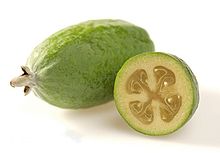| Acca sellowiana | |
|---|---|
 | |
| Fruit | |
| Scientific classification | |
| Kingdom: | Plantae |
| (unranked): | Angiosperms |
| (unranked): | Eudicots |
| (unranked): | Rosids |
| Order: | Myrtales |
| Family: | Myrtaceae |
| Genus: | Acca |
| Species: | A. sellowiana |
| Binomial name | |
| Acca sellowiana (O.Berg) Burret | |
| Synonyms | |
| Feijoa sellowiana (O.Berg) O.Berg Orthostemon sellowianus O.Berg[1] | |
Contents |
Fruit
The fruit, maturing in autumn, is green, ellipsoid, and about the size of a chicken egg. It has a sweet, aromatic flavor. The flesh is juicy and is divided into a clear gelatinous seed pulp and a firmer, slightly gritty, opaque flesh nearer the skin. The fruit drops when ripe and at its fullest flavor, but may be picked from the tree prior to the drop to prevent bruising.The fruit pulp resembles the closely related guava, having a gritty texture. The Feijoa pulp is used in some natural cosmetic products as an exfoliant. Feijoa fruit has a distinctive smell. The aroma is due to the ester methyl benzoate and related compounds that exist in the fruit.
Growing conditions
It is a warm-temperate to subtropical plant that also will grow in the tropics, but requires some winter chilling to fruit and the plant is frost-tolerant.In the northern hemisphere this species has been cultivated as far north as western Scotland, but under such conditions it does not fruit every year, as winter temperatures below approximately −9 °C (16 °F) kill the flower buds.
Seasonality
Large quantities of the fruit are grown in New Zealand, where it is a popular garden tree and the fruit commonly is available in season. The New Zealand season runs from March to June.Harder varieties are grown for years in Russian region of Buriatia (city Ulan-Ude), with winters up to -40 C.
Consumption and uses
The fruit usually is eaten by cutting it in half, then scooping out the pulp with a spoon.[4] The fruit has a juicy sweet seed pulp and slightly gritty flesh nearer the skin. The flavour is aromatic and sweet. If the utensils needed to eat it this way are not available, the Feijoa may be torn or bitten in half, and the contents squeezed out and consumed. An alternative method is to bite the end off and then tear the fruit in half length ways, exposing a larger surface with less curvature and using one's teeth to scrape the pulp out closer to the skin. This method results in less waste of the fruit.A Feijoa may be used as an interesting addition to a fruit smoothie, and may be used to make Feijoa wine or cider and feijoa infused vodka. It also is possible to buy Feijoa yogurt, fruit drinks, jam, ice-cream, and such in New Zealand. The Feijoa also may be cooked and used in dishes where one would use stewed fruit. It is a popular ingredient in chutney.
Fruit maturity is not always apparent visually as the fruits remain the same shade of green until they are over-mature or rotting. One usually may sense ripeness, however, by giving the fruit a soft squeeze; a ripe Feijoa will give somewhat like a just-ripe banana. Generally, the fruit is at its optimum ripeness the day it drops from the tree. While still hanging it may well prove bitter, however, once fallen, fruit very quickly becomes over-ripe, so a daily collection of fallen fruit is advisable during the season.
When the fruits are immature the seed pulp is white and opaque. It becomes clear and gelatinous when ripe. Fruits are at their optimum maturity when the seed pulp has turned into a clear jelly with no hint of browning. Once the seed pulp and surrounding flesh start to brown, the fruit is over-mature, but still may be eaten. Over-mature but not rotten fruits may be used to make a delicious juice very popular in places such as the Colombian Highlands.[citation needed]
The pink to white flower petals have a delightful flavor, being crisp, moist, and fleshy. They regularly are consumed by birds.
Sale and shipping
Ripe fruit is very prone to bruising; maintaining the fruit in good condition for any length of time is not easy. This, along with the short period of optimum ripeness and full favor, probably explains why Feijoas, although delicious, frequently are not exported, and where grown commercially, often only are sold close to the source of the crop.Because of the relatively short shelf-life, store keepers need to be careful to replace older Feijoas regularly to ensure high quality. In some countries, Feijoas also may be purchased at roadside stalls, often at a lower price.
Feijoas may be cool-stored for approximately a month and still have a few days of shelf life at optimum eating maturity. They also may be frozen for up to one year without a loss in quality.
Cultivation
Some grafted cultivars of Feijoa are self-fertile. Most are not, and require a pollinator. Seedlings may or may not be of usable quality, and may or may not be self fertile.In New Zealand, the pollinators of this plant are bees, bumblebees, or medium-sized birds. The latter include such as the Silvereye in the cooler parts of the South Island, the blackbird, or the Indian myna farther north, which feed on the sweet, fleshy petals of the Feijoa flower.
In California, robins, mockingbirds, hummingbirds, starlings, scrub jays, towhees, and grey squirrels feast on the petals and are presumed to be assisting with pollination.[citation needed] Honeybees also visit the flowers.
In some areas where the species has been introduced, however, the trees have been unproductive due to lack of pollinators. The shrub has very few insect pests.




No comments:
Post a Comment